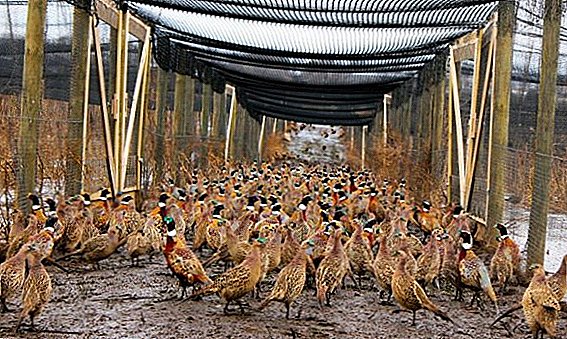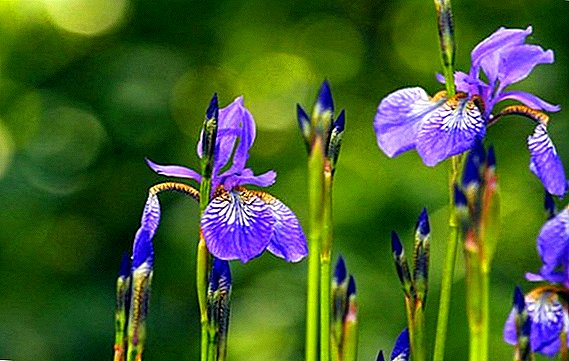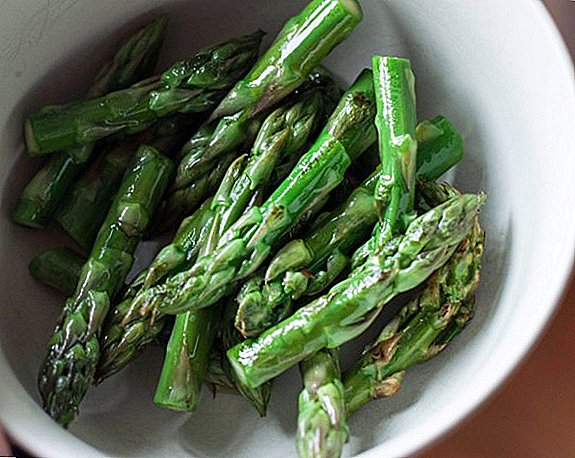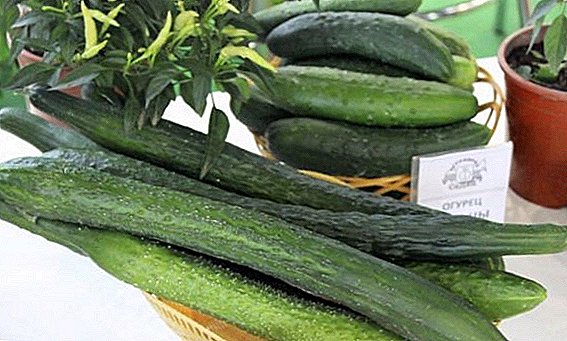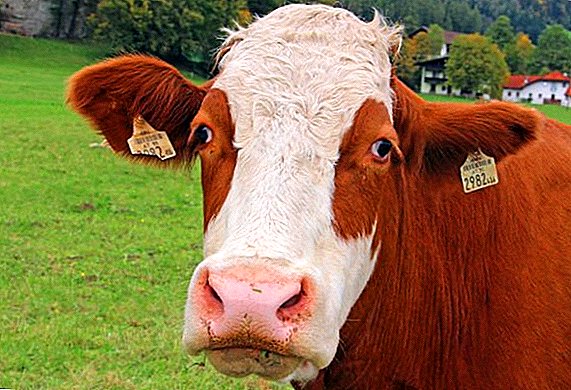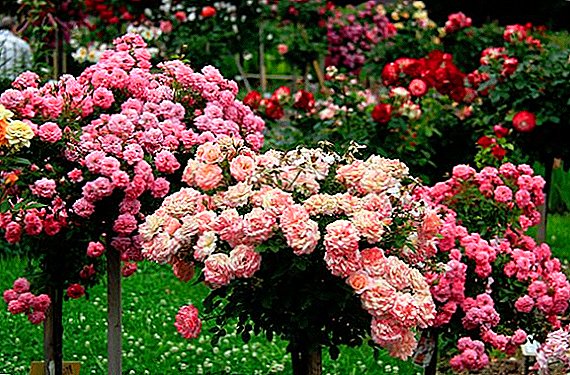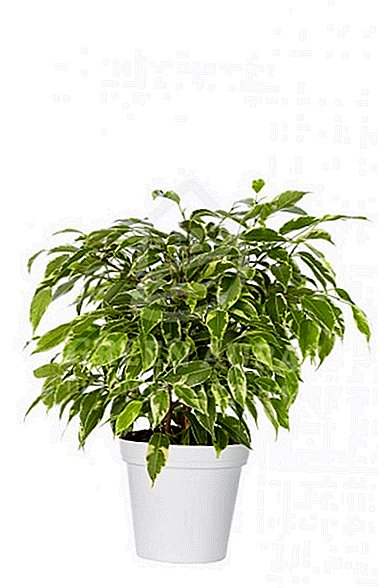 In the world there is a huge variety of ficuses, but as a houseplant most often only one species is used - Benjamin's ficus (also known as Brilliant). This plant, due to its unpretentiousness and unique glossy leaves, a large number of varieties and hybrids, differing not only by external signs (size, color of leaves, crown shape, etc.), but also the basic requirements for care, has gained many admirers. One of the most interesting ficus species of Benjamin is the dwarf variety Kinki.
In the world there is a huge variety of ficuses, but as a houseplant most often only one species is used - Benjamin's ficus (also known as Brilliant). This plant, due to its unpretentiousness and unique glossy leaves, a large number of varieties and hybrids, differing not only by external signs (size, color of leaves, crown shape, etc.), but also the basic requirements for care, has gained many admirers. One of the most interesting ficus species of Benjamin is the dwarf variety Kinki.
Dwarf ficus by Benjamin Kinki
The birthplace of ficus varieties Benjamin tropical forests of northern Australia, West Africa, East Asia, India, China, Hawaiian and Philippine Islands.
But the Kinki are a product of the efforts of an unknown breeder. The rights to this hybrid are not registered, even the time and place where the variety was first bred is secret.
Did you know? The word "kinky" in translation from English means "curly", and this is how the name is usually translated, suggesting that in this way the unknown author wanted to show the variety's pomp unusual for wild ficus. But this word has a few more translations, in particular, “eccentric” and “seductive”. Looking at this small but insanely beautiful plant and examining its “character”, we can conclude that perhaps these very names of ficus reflect its essence in the best way possible.
So, we are talking about a very small plant, it reaches a maximum of 35-40 cm in height. But it branches magnificently and forms a lush crown in the shape of a ball, which with age, if the tree is not formed, begins to "fall apart", throwing out branches in all directions. Numerous veins of the trunks are covered with a grayish bark, when they are formed they are sometimes tied together.  The leaves are alternate, as it should be a ficus, glossy, with thin skin, have an elongated shape with a pointed tip, slightly curved down. Leaf sizes are 30-40 mm long and 10-20 mm wide.
The leaves are alternate, as it should be a ficus, glossy, with thin skin, have an elongated shape with a pointed tip, slightly curved down. Leaf sizes are 30-40 mm long and 10-20 mm wide.
Kinki refers to a particularly decorative variegated ficus. In young plants, the uneven edging of the leaf plate is light green, with age it brightens and becomes beige or white.
Read also about the cultivation of ficus Benjamin, as well as its varieties.
How to choose a plant when buying
It is good to buy ficus directly from amateur flower growers specializing in breeding these evergreen tropical beauties.  In such a home greenhouse will never be sick or neglected plant, besides all the necessary advice on the content of the flower will provide a true professional.
In such a home greenhouse will never be sick or neglected plant, besides all the necessary advice on the content of the flower will provide a true professional.
Did you know? Bangkok, the capital of Thailand, a huge and beautiful city, famous for its numerous Buddhist temples, palaces and vibrant nightlife, chose Benjamin Ficus as his symbol.
In stores, even specialized ones, the risk of being mistaken is much higher. If the plant is purchased in the trading network, you should verify the quality of the product by performing the following manipulations:
- Inspect the plant. Make sure that it is visually healthy, has no damage, signs of decay, yellow or dried leaves, broken branches, etc.
- Take a pot of ficus and gently shake it.. A healthy plant intended for sale should not discard foliage, so even one fallen leaf speaks of the trader’s bad faith.
- Pay attention to the ground. It should not be overwetted. The slightest signs of an unpleasant smell (rot, mildew, etc.) are a reason to refuse to buy.
- Raise the pot and look inside it through the drainage holes.. Healthy roots are not dark brown or black. A bad sign is also an abundance of roots protruding from the holes in the pot, which means that the flower is too crowded, besides, with the transshipment of such a plant, problems will inevitably arise.
- Too much gloss on the leaves is often the result of the seller’s unscrupulous tricks.: the plant is rubbed with various polishes and wax. Such substances clog the pores in the leaf plate, which, in turn, blocks the normal metabolic processes. If the procedure was carried out quite recently, there is no big problem in this, simply by acquiring such a ficus, each leaf should be thoroughly wiped with a damp cloth dipped in warm water. But is it worth buying a product from a seller who allows such treatment with a plant - let everyone decide for himself.
In case the acquired ficus still has hidden diseases that were not detected during the initial examination, do not rush to immediately place it nearby with other ornamental plants.  Arrange for a new "tenant" a two-week quarantine, during which time all possible problems will surely manifest themselves.
Arrange for a new "tenant" a two-week quarantine, during which time all possible problems will surely manifest themselves.
Important! Experts do not recommend purchasing ficuses in the cold season, because during the rest period the plant is very difficult to adapt to a new place.
Another tip: it is always better to buy a small, not an adult plant..
Of course, it will take a long time until it acquires the desired size, and the formation of the crown is a delicate matter, but young figs are much easier to tolerate moving and changing the situation, while a luxurious and lush tree is more likely to start dropping foliage, drying out and losing all its beauty.
It will take several months until it gets used to the new environment.
Conditions for ficus Kinki in the room
Ficus Kinki requires more careful care than its wild relatives, and in the absence of proper "understanding" it may well show its eccentric character.
But if you immediately create the necessary conditions for the plant, in the subsequent special difficulties with the content of curly handsome should not be.
Video: planting and care for the Kinki ficus
Temperature and humidity
In terms of temperature requirements, the ficus plant is quite unpretentious. He likes quite cool air within +20 ° C (plus or minus a couple of degrees), but in the warm season it can easily endure the thirty-degree heat.
Like any houseplant, Kinki does not like drafts and a sharp change in heat and cold.
Important! Put the ficus in the winter on the windowsill next to the central heating battery and at the same time open the window - means to kill the flower!
In the winter season, when the plant is at rest, it is better to provide cool conditions (from +15 ° C to +18 ° C).
If the room is too warm, Kinki begins to suffer from excessively dry air, while excessive watering at this time of year does not suit the plant, so saving the situation requires regular moistening, for example, putting dishes with moisture-absorbing material next to the pot and filling it with water.
Except for the above, the ficus is not too picky about the humidity of the air, but it treats periodic bathing very favorably (however, arranging a shower flower, you first need to protect the soil from excessive water ingress into it). 
Proper lighting
Ficus plants - tropical plants, and therefore light-loving. But, as in any tropical forest, the light should not be direct, but diffused. If you have a choice, it is best to place a pot with a dwarf flower near the window overlooking the west or east side.
Important! Try not to transfer the ficus from place to place: the plant does not like "moving" very much and hardly adapts.
And yet in the summer, the pot can be taken out onto the open balcony, providing protection to the plant from too bright sunlight.
Pot and soil requirements
Properly chosen pot is very important for the development of indoor flower. For dwarf ficus fit both plastic and ceramics, it is important that the capacity matches the size of the plant.
If the pot is too large, the process of strengthening the root system will be delayed in time, and the plant will stop growing for a long time.  But even in too cramped conditions, the ficus cannot develop normally.
But even in too cramped conditions, the ficus cannot develop normally.
Ideally, when a new pot is 2-3 cm larger than the previous one, the proportion can be slightly larger in height.
It will be useful for you to learn how to pick up the soil and a pot for a ficus transplant.
Kinki fits a loose fertile soil with a neutral pH level, but in a slightly acidic soil the flower will also feel good.
Specially selected soil mixture for ficus sold in any specialty store.
If you want to experiment, then the soil for the flower can be “made” by yourself, for this you need to take in equal quantities:
- turf ground;
- humus;
- river sand coarse fraction;
- peat.
In order to avoid rotting of the roots, a thick drainage layer should be placed on the bottom of the pot.  Beginners "ficusovodam" need to know another very important rule, the fulfillment of which depends on the healthy life of the flower.
Beginners "ficusovodam" need to know another very important rule, the fulfillment of which depends on the healthy life of the flower.
Important! Acquired in the store plant must be transplanted into a new pot, while completely changing the soil to fresh.
The fact is that flower shops of the plant, especially imported, come in the ground, specially designed for transportation and sale (the so-called shipping soil).
Typically, it is based on peat - the substrate is very nutritious and moisture-consuming. In such a soil, the plant can not be watered for a long time, but it is very easy to pour, because outside the soil looks dry, and inside it continues to retain moisture.
In addition, the mixture stuffed with fertilizers is relatively quickly depleted, and the flower ceases to receive the nutrients necessary for normal development.
Read also how to feed indoor plants.
In a word, the earth in the pot in which you bought the ficus is initially considered as temporary, and it should be replaced immediately so that after this you don’t disturb the flower with new shocks.
Ficus Kinki at home: how to properly care
So, the dwarf tree is selected, delivered to the house, transplanted and installed in the right place. Now it's time to leave regularly. Here, too, has its own rules.
How to water the plant
Kinki does not tolerate overflow, but, of course, it should not dry up the ground.  Watering is recommended moderate, as drying of the top layer of soil, it is necessary to use at the same time well-settled water heated to ambient temperature.
Watering is recommended moderate, as drying of the top layer of soil, it is necessary to use at the same time well-settled water heated to ambient temperature.
Read the rules of watering ficus.
Top dressing and fertilizer
Feed the plant should be only in the period from the beginning of active growth (with increasing daylight hours, that is, from February) until autumn.
Root top dressing is applied once every two weeks, but after reducing the daylight hours the number of such procedures is gradually reduced.
By mid-autumn, fertilizing can be stopped so that the flower can enter the resting phase.
Kinki fits the usual universal fertilizer for indoor plants.
Important! A lack of fertilizers will slow down the development of ficus, but an oversupply of minerals in the soil can seriously harm the tree.
Crown formation and flower trimming
The formation of Kinki is a complex process, but at the same time very fascinating.
This dwarf tree can be given various forms - from a regular regular ball to intricate shapes or the popular bonsai style (compact crown with short shoots imitating a real dwarf tree, from Japanese - “grown in a tray”).  There are many varieties of bonsai, any of them can be tested on your dwarf pet:
There are many varieties of bonsai, any of them can be tested on your dwarf pet:
- Tekkan - straight trunk, naked in the lower part, crown, resembling a triangle (the length of the branches decreases to the top);
- moyogi - the trunk is directed upwards, but in one or several places it is elegantly arched, the crown is small, compact;
- syakan - the tree is noticeably bent in one direction, and from the other it appears as if bare roots stick out;
- sokan - a tree is formed into two trunks of different sizes, like a father and son;
- hokidati - the crown is symmetrically sprawling, shaped like a broom;
- esueue, a kind of mini-forest - several, at least five plants will be placed in one pot (you can even use different types of figs) that differ in age and size.
In addition to the crown, in an unusual way you can arrange the trunk of a tree.
It is Kinki that are often intertwined with original decorative braids, tied together with a string, twisted in a bizarre way - in a word, there is the widest scope for fantasy!
Video: Kinki ficus bonsai By the way, the rather whimsical dwarf ficus is quite favorably related to such experiments on itself, which is greatly facilitated by the surprising elasticity of its shoots.
Important! Trimming the ficus, you need to be careful: the milky juice, which is released when cutting leaves or branches, contains toxic substances that can cause irritation to the skin and other types of allergic reactions.
The tree grows quite quickly, branches well and imperceptibly overgrown with a lush crown, so you can not run it. However, this process should be engaged in the phase of active growth, that is, from spring to early summer.
Of course, the basis of the "haircut" should be set while the plant is young, later it will only remain to maintain the chosen shape.
There are several requirements for proper pruning.:
- the instrument must be sharp and sterile;
- the leaves need to be cut, but not cut off;
- it is very important not to damage the bark;
- you should first consider the form, draw up a plan, and only then proceed to implement it.
Transplantation and reproduction of ficus
After the first transplant, it is better to leave Kinki alone for at least a year so that the dwarf ficus adapts to the new location. Then, in February-March, the transshipment is carried out in a larger pot until the flower becomes an adult.
Then the number of transplants is reduced, carrying out this procedure as needed, when the former pot becomes obviously cramped for an older tree.  In contrast to the forced transplant from transport soil, subsequent transplants do not require soil replacement. On the contrary, you need to try to make sure that the tree does not feel anxiety.
In contrast to the forced transplant from transport soil, subsequent transplants do not require soil replacement. On the contrary, you need to try to make sure that the tree does not feel anxiety.
Familiarize yourself with the most popular types of ficuses, in particular, with lyre, rubber, ficus myocarp, Melanie, Robusta and Abidjan, also learn how to propagate ficus at home.
The earthen clod is carefully removed from the pot and moved to a new one, after which the remaining voids are carefully filled with fresh soil mixture.
For breeding ficuses, you can use cuttings or stems.
It is enough to cut off the shoot with two or three leaves, put it in a glass with water until the roots appear (it usually takes up to two weeks) and put it in a small container with nutrient soil.  Reproduction of ficus Kinki cuttings When the plant is rooted and strengthened, it can be moved to a real pot.
Reproduction of ficus Kinki cuttings When the plant is rooted and strengthened, it can be moved to a real pot.
In nature, ficuses also multiply by seeds, but for an ornamental plant this method is poorly suited: first, for too long; secondly, there is no guarantee of preserving the original qualities of the parent plant.
Diseases and pests of domestic plants
Like other indoor flowers, Kinki often suffer from scutes, spider mites, and aphids.
Did you know? Not all ficuses are trees in the full sense of the word. Among the representatives of this genus there are epiphytes, that is, plants that do not have a connection with the soil, but feed on donor trees, wrapping them around with powerful branches and sucking vital juices out of them until the unfortunate "breadwinner" dies.
As a "first aid" at first, a warm shower helps well, and the water must be used at fairly high temperatures - up to 45 ° C to eliminate pests.
If recovery has not come, it remains to resort to chemical treatment with insecticides.
Very often Kinky owners face the problem of dropping foliage from a tree.
This is always the result of improper care. We have already spoken about some of the errors that cause a similar reaction, but summarize the possible causes of leaf fall again.  Kinki reacts by dropping leaves on:
Kinki reacts by dropping leaves on:
- unplanned transplant after purchase (leaving the plant in the transport ground);
- sudden changes in temperature, especially the simultaneous exposure to warm and cold air;
- too low (less than +15 ° C) or too high (above +30 ° C) temperature;
- drafts;
- moving from place to place;
- watering with cold water;
- excessive amount of fertilizer;
- lack of lighting or getting into the zone of direct sunlight;
- untimely transplant (lack of food due to the cramped pot).
Read also what to do if Benjamin's ficus sheds foliage.
Kinki means eccentricity and seductiveness. Dwarf ficus with this name is quite demanding indoor plants, responsive to any mistakes inexperienced or careless grower.
But, having understood the preferences of your pet, you will get an incomparable pleasure with anything, weaving original combinations of elastic branches, arching and directing, according to the conceived plan, an elegant trunk and forming an unusual crown in any style that suits your tastes and preferences.



